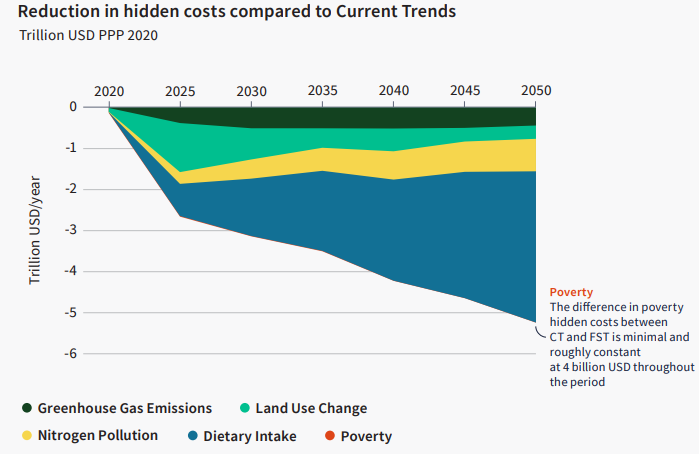Introduction
Currently, our food systems are causing more harm than good. The 2023 Food System Economics Commission (FSEC) report highlights the harm caused by current food systems and the need for a global transformation. This transformation, focusing on inclusivity, diverse economic insights, and systemic change, could address climate, environmental, and health crises, improving many lives and potentially generating up to $10 trillion annually. This summary article summarizes the FSEC four-year investigation and their suggested strategies for change.
The costs of current food systems
Since the 1970s, the global population has doubled, and the food systems have successfully fed this growing number of people. Yet, these systems also inflict costs on society, estimated at around 15 trillion USD per year. These costs comprise:
- Health costs: Estimated to be 11 trillion USD, based on the detrimental impacts on labor productivity caused by food-related illnesses.
- Environmental costs: The detrimental effects of food systems on ecosystems and the climate are estimated to be worth $3 trillion USD.
- Structural poverty: Food systems contribute to structural poverty due to high food prices and poor earnings.
Cutting on these costs could benefit societies with an economic gain estimated to be 10 USD per year. Figure 1 offers an overview of the drivers that could contribute to this economic gain by 2050.

Shared Goal for Food Systems
While there is no one-size-fits-all approach, according to FSEC five key priorities should be implemented globally. Combining policies into unified strategies to target these priorities enhances the chance of success:
- (1) Universal healthy diet consumption;
- (2) Robust livelihoods in the food system;
- (3) Preservation and restoration of lands;
- (4) Sustainable food production;
- (5) Resilient food systems ensuring ongoing food and nutrition security.
The pathways towards Food Systems Fit for the Future
The FSEC affirms that food system reform is feasible and has developed a science-based Food System Transformation (FST) pathway for five goals by 2050. The FSEC’s pathways, which integrate specialized models, compare potential food system developments considering current trends, a comprehensive transformation, and an extended transformation with sustainable changes. The FST method aims to eliminate food insecurity, improve diet health, reduce nutrition-related deaths, limit global warming, reverse biodiversity loss, and halve nitrogen surpluses.
The unsustainability of current food systems
Unfortunately, the food systems are on a trajectory that is not sustainable. Even with policy commitments, altering this course seems improbable. If this continues, the FST approach will likely be unsuccessful in transforming food systems. As per the FSEC, the following trends could hinder the success of FST pathways:
- Food insecurity, with 640 million people being undernourished, especially in India, Southeast Asia, and Sub-Saharan Africa.
- Increase in the obese population and adoption of diets in ultra-processed foods.
- Increase in per capita food waste by 16%.
- Increased vulnerability of the food production chain, due to climate change and extreme events.
- Increase in nitrogen (N) released in the environment from 245 mt N to 300 mt N.
Impact of disasters on food security
Food Systems Transformation major achievements
Despite the challenges, according to the FSEC, findings suggest that swiftly implementing all FST measures can achieve transformative change and address systemic failures and sustainability issues by 2050. However, deviating significantly from the current trends, posing immediate and long-term risks to health, climate, biodiversity, and inclusion, is a substantial challenge. Major achievements of implementing the FST method will be:
- By 2040, the FST will transform the land sector into a net carbon sink, limiting peak global mean temperature to slightly above 2.0°C, paired with external transformations (FXT) could lower the temperature by an extra 1.5°C.
- Transitioning to sustainable agricultural practices could reverse biodiversity loss, cut irrigation water demand, and nearly halve nitrogen surplus from farming and natural land.
- Enhanced trade integration and diversified routes better link regions with food surpluses and deficits.
- FST will eliminate food insecurity, enhance dietary health, and significantly cut nutrition-related deaths in all regions. Dietary shifts could also reduce the need for higher crop yields, and avoid a rise in commodity prices.
Figure 2 shows the expected outcome of global premature mortality in 2050, comparing the results of current trends and FST and FXT.
- The FST will reduce worldwide per capita food waste by 24% from 2020 to 2050.
- FST will boost the labor shift from agriculture, with other food sectors, especially in poorer countries, likely to take on more jobs.

Strategies for Food Systems Transformation
Food system transformation needs science-backed national strategies with clear targets. Policies should be comprehensive, locally tailored but globally focused, and inclusive to balance trade-offs and support vulnerable groups. The FSEC proposes these methods:
- All countries should design food system transformation strategies. These strategies should be coherent, synergetic, and focus on areas where policy will have maximum effect.
- Governments should invest in incentives and regulations that steer the choices of food system actors and support positive externalities while reducing negative externalities. This includes taxing, mandatory restrictions, or reducing transition costs.
- The public systems should support innovation uptake, that contributes to the development of more environmentally sustainable farming systems. This includes digitalization of the food chain.
- Creating safety nets, to make food affordable for everyone.
Early warning food safety AI tools
The consequences of failure
Food system transformation, while beneficial, creates tensions among potential winners and losers. These tensions, including fears of food price rises, job losses, policy siloes, global inequalities, and entrenched vested interests, need innovative policy implementation to be managed. Without addressing them, the transformation will be hindered.
Source
Ruggeri Laderchi, C., Lotze-Campen, H., DeClerck, F., Bodirsky, B.L., Collignon, Q., Crawford, M.S., Dietz, S., Fesenfeld, L., Hunecke, C., Leip, D., Lord, S., Lowder, S., Nagenborg, S., Pilditch, T., Popp, A., Wedl, I., Branca, F., Fan, S., Fanzo, J., Ghosh, J., HarrissWhite, B., Ishii, N., Kyte, R., Mathai, W., Chomba, S., Nordhagen, S., Nugent, R., Swinnen, J., Torero, M., Laborde Debouquet, D., Karfakis, P., Voegele, J., Sethi, G., Winters, P., Edenhofer, O., Kanbur, R., & Songwe, V. (2024). The Economics of the Food System Transformation. Food System Economics Commission (FSEC), Global Policy Report.
Related articles to Food Systems transformation based on a new economic system
Many customers and visitors to this page 'Food Systems transformation based on a new economic system' also viewed the articles and manuals listed below:



